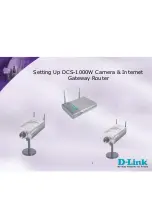
1-2
z
Loop-free: Computes routes with the shortest path first (SPF) algorithm according to collected link
states, so no route loops are generated.
z
Area partition: Allows an AS to be split into different areas for ease of management and routing
information transmitted between areas is summarized to reduce network bandwidth consumption.
z
Equal-cost multi-route: Supports multiple equal-cost routes to a destination.
z
Routing hierarchy: Supports a four-level routing hierarchy that prioritizes routes into intra-area,
inter-area, external Type-1, and external Type-2 routes.
z
Authentication: Supports interface-based packet authentication to ensure the security of packet
exchange.
z
Multicast: Supports multicasting protocol packets on some types of links.
Basic Concepts
Autonomous System
A set of routers using the same routing protocol to exchange routing information constitute an
Autonomous System (AS).
OSPF route computation
OSPF route computation in an area is described as follows:
z
Based on the network topology around itself, each router generates Link State Advertisements
(LSA) and sends them to other routers in update packets.
z
Each OSPF router collects LSAs from other routers to compose a LSDB (Link State Database). An
LSA describes the network topology around a router, so the LSDB describes the entire network
topology of the AS.
z
Each router transforms the LSDB to a weighted directed graph, which actually reflects the topology
architecture of the entire network. All the routers have the same graph.
z
Each router uses the SPF algorithm to compute a Shortest Path Tree that shows the routes to the
nodes in the autonomous system. The router itself is the root of the tree.
Router ID
An OSPF process running on a router must have its own router ID, which is a 32-bit unsigned integer,
the unique identifier of the router in the AS.
OSPF packets
OSPF uses five types of packets:
z
Hello packet: Periodically sent to find and maintain neighbors, containing the values of some timers,
information about the DR, BDR and known neighbors.
z
DD packet (database description packet): Describes the digest of each LSA in the LSDB,
exchanged between two routers for data synchronization.
z
LSR (link state request) packet: Requests needed LSAs from the neighbor. After exchanging the
DD packets, the two routers know which LSAs of the neighbor are missing from the local LSDBs.
Then, they send an LSR packet to each other, requesting the missing LSAs. The LSA packet
contains the digest of the missing LSAs.
z
LSU (link state update) packet: Transmits the needed LSAs to the neighbor.
Содержание S7902E
Страница 82: ...1 4 DeviceA interface tunnel 1 DeviceA Tunnel1 service loopback group 1 ...
Страница 200: ...1 11 DeviceB display vlan dynamic No dynamic vlans exist ...
Страница 494: ...ii Displaying and Maintaining Tunneling Configuration 1 45 Troubleshooting Tunneling Configuration 1 45 ...
Страница 598: ...ii ...
Страница 1757: ...4 9 ...
Страница 1770: ...6 4 ...
Страница 2017: ...2 11 Figure 2 3 SFTP client interface ...
Страница 2062: ...i Table of Contents 1 URPF Configuration 1 1 URPF Overview 1 1 What is URPF 1 1 How URPF Works 1 1 Configuring URPF 1 2 ...
Страница 2238: ...1 16 DeviceA cfd linktrace service instance 1 mep 1001 target mep 4002 ...
Страница 2442: ...2 4 Set the interval for sending Syslog or trap messages to 20 seconds Device mac address information interval 20 ...
















































